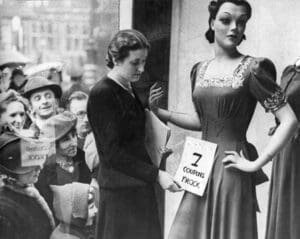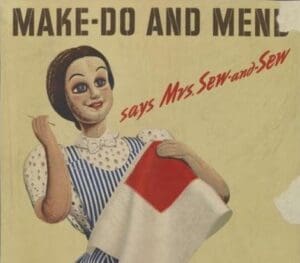While there are many large and clearly unfortunate problems WWll created, today, we’re discussing how the rationing of clothing materials in the U.S. during the war made getting dressed much more challenging. Wondering why clothing was so hard to get? Well, the USA made millions of uniforms for our troops, putting a huge dent in the country’s supply of textiles – and some exports, such as silk from Japan, were cut off entirely.

(image via express via getty)
Fashion was all about using what you had, so a lot of pieces were customized. Cloth itself was hard to come by, so people got creative: Paint was used on clothing to give pops of color or patterns where garments were lacking, embroidery and homemade trim were stitched onto pieces, contrasting pockets were added to dresses, and people didn’t think twice about making dresses or tops out of feed sacks. An entire campaign known as “Make Do and Mend” encouraged people to make their current clothes last longer.
In March 1942, restrictions worsened. The U.S. War Production Board issued order L-85, which reduced the number of textiles used in women’s wear by 15%. This meant that clothing lengths and widths were all restricted. The WPB also prohibited pleats, ruffles, patch pockets, hoods, shawls, and full sleeves or skirts. In addition, hems and fabric belts could not be wider than two inches, and only one pocket was allowed per garment. The only exceptions were wedding gowns, maternity clothes, and religious wear.

(image via imperial war museums)
Despite everything happening around them, women were still expected to keep up their appearance. While being out in flashy clothing was frowned upon, not caring about their appearance was also not acceptable. The government tossed around the idea of discontinuing the production of cosmetics but ultimately decided against it because they feared it would lower women’s morale and have a detrimental effect on the war effort. While makeup was never rationed, it was very expensive.
Sources: Harper’s Bazaar, Sarah Sundin, Imperial War Museums






